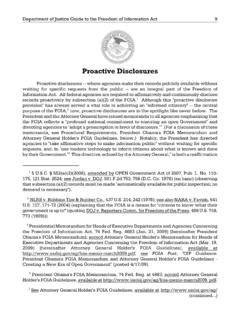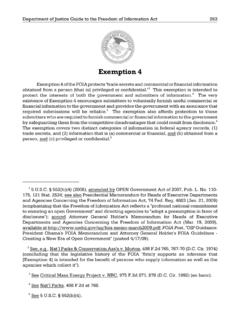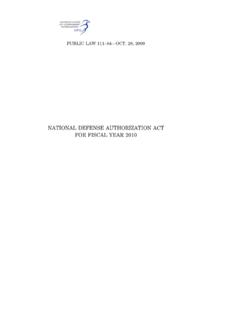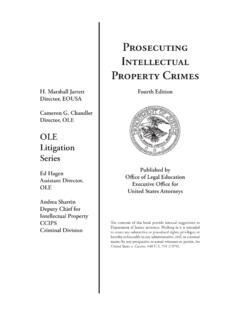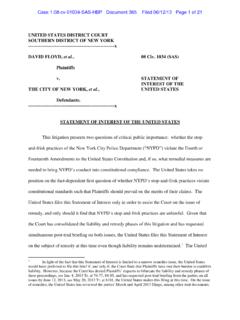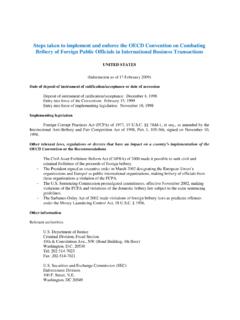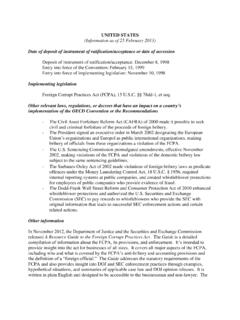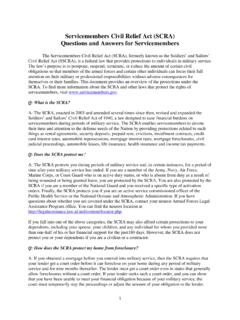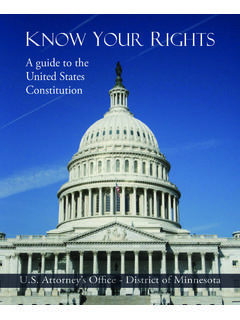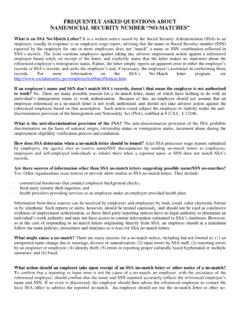Transcription of OVERVIEW OF THE PRIVACY ACT OF 1974 TABLE OF …
1 OVERVIEW OF THE PRIVACY ACT OF 1974. TABLE OF CONTENTS. 1. LEGISLATIVE HISTORY .. 1. ROLE OF THE PRIVACY PROTECTION STUDY COMMISSION .. 1. ROLE OF THE OFFICE OF MANAGEMENT AND BUDGET .. 2. COMPUTER 3. POLICY OBJECTIVES .. 4. DEFINITIONS .. 4. A. Agency .. 4. B. Individual .. 14. C. Maintain .. 17. D. Record .. 17. E. System of Records .. 28. 1) Disclosure: Subsection (b) .. 34. 2) Access and Amendment: Subsections (d)(1) and (d)(2) .. 46. 3) Other 48. CONDITIONS OF DISCLOSURE TO THIRD PARTIES .. 52. A. The "No Disclosure Without Consent" Rule .. 52. B. Twelve Exceptions to the "No Disclosure Without Consent" Rule .. 65. 1) 5 USC 552a(b)(1) ("need to know" within agency) .. 65. 2) 5 USC 552a(b)(2) (required FOIA disclosures) .. 74. 3) 5 USC 552a(b)(3) (routine uses) .. 79. 4) 5 USC 552a(b)(4) (Bureau of the Census) .. 94. 5) 5 USC 552a(b)(5) (statistical research) .. 95. 6) 5 USC 552a(b)(6) (National Archives) .. 95. 7) 5 USC 552a(b)(7) (law enforcement request).
2 96. 8) 5 USC 552a(b)(8) (health or safety of an individual) .. 97. 9) 5 USC 552a(b)(9) (Congress) .. 97. 10) 5 USC 552a(b)(10) (Government Accountability Office) .. 98. 11) 5 USC 552a(b)(11) (court order) .. 98. 12) 5 USC 552a(b)(12) (Debt Collection Act) .. 109. ACCOUNTING OF CERTAIN DISCLOSURES .. 109. INDIVIDUAL'S RIGHT OF ACCESS .. 112. INDIVIDUAL'S RIGHT OF AMENDMENT .. 122. AGENCY REQUIREMENTS .. 123. A. 5 USC 552a(e)(1) .. 123. B. 5 USC 552a(e)(2) .. 124. C. 5 USC 552a(e)(3) .. 128. D. 5 USC 552a(e)(4) .. 132. E. 5 USC 552a(e)(5) .. 133. F. 5 USC 552a(e)(6) .. 145. G. 5 USC 552a(e)(7) .. 146. H. 5 USC 552a(e)(8) .. 154. I. 5 USC 552a(e)(9) .. 155. J. 5 USC 552a(e)(10) .. 155. K. 5 USC 552a(e)(11) .. 157. AGENCY RULES .. 157. A. 5 USC 552a(f)(1) .. 157. B. 5 USC 552a(f)(2) .. 158. C. 5 USC 552a(f)(3) .. 158. D. 5 USC 552a(f)(4) .. 161. E. 5 USC 552a(f)(5) .. 161. CIVIL REMEDIES .. 161. A. Amendment Lawsuits under (g)(1)(A).. 168. B. Access Lawsuits under (g)(1)(B).
3 180. C. Damages Lawsuits under (g)(1)(C) .. 186. D. Damages Lawsuits under (g)(1)(D) .. 201. E. Principles Applicable to Damages Lawsuits .. 210. 1) Intentional/Willful Standard .. 210. 2) Actual Damages .. 224. F. Principles Applicable to All PRIVACY Act Civil Actions .. 231. 1) Attorney Fees and Costs .. 231. 2) Jurisdiction and 236. 3) Statute of Limitations .. 239. 4) Jury 259. CRIMINAL PENALTIES .. 260. TEN EXEMPTIONS .. 261. A. One Special Exemption -- 5 USC 552a(d)(5) .. 261. B. Two General Exemptions -- 5 USC 552a(j)(1) and (j)(2) .. 263. C. Seven Specific Exemptions -- 5 USC 552a(k) .. 275. 1) 5 USC 552a(k)(1) .. 276. 2) 5 USC 552a(k)(2) .. 277. 3) 5 USC 552a(k)(3) .. 284. 4) 5 USC 552a(k)(4) .. 284. 5) 5 USC 552a(k)(5) .. 284. 6) 5 USC 552a(k)(6) .. 288. 7) 5 USC 552a(k)(7) .. 289. SOCIAL SECURITY NUMBER USAGE .. 289. GOVERNMENT CONTRACTORS .. 294. MAILING LISTS .. 295. MISCELLANEOUS PROVISIONS .. 296. TEXT OF THE PRIVACY ACT OF 1974 .. 299. OVERVIEW OF THE PRIVACY ACT.
4 INTRODUCTION. The PRIVACY Act of 1974, 5 552a (2006), which has been in effect since September 27, 1975, can generally be characterized as an omnibus code of fair information practices . that attempts to regulate the collection, maintenance, use, and dissemination of personal information by federal executive branch agencies. However, the Act 's imprecise language, limited legislative history, and somewhat outdated regulatory guidelines have rendered it a difficult statute to decipher and apply. Moreover, even after more than thirty -five years of administrative and judicial analysis, numerous PRIVACY Act issues remain unresolved or unexplored. Adding to these interpretational difficulties is the fact that many earlier PRIVACY Act cases are unpublished district court decisions. A particular effort is made in this OVERVIEW to clarify the existing state of PRIVACY Act law while at the same time highlighting those controversial, unsettled areas where further litigation and case law development can be expected.
5 LEGIS LATIVE HIS TORY. The entire legislative history of the PRIVACY Act is contained in a convenient, one-volume compilation. See House Comm. on Gov't Operations and Senate Comm. on Gov't Operations, 94th Cong., 2d Sess., Legislative History of the PRIVACY Act of 1974 S. 3418. (Pub. L. No. 93-579) Source Book on PRIVACY (1976) [hereinafter Source Book], available at ilitary_Law/ The Act was passed in great haste during the final week of the Ninety -Third Congress. No conference committee was convened to reconcile differences in the bills passed by the House and Senate. Instead, staffs of the respective committees led by Senators Ervin and Percy, and Congressmen M oorhead and Erlenborn prepared a final version of the bill that was ultimately enacted. The original reports are thus of limited utility in interpreting the final statute; the more reliable legislative history consists of a brief analysis of the compromise amendments entitled Analysis of House and Senate Compromise Amendments to the Federal PRIVACY Act.
6 Prepared by the staffs of the counterpart Senate and House committees and submitted in both the House and Senate in lieu of a conference report. See 120 Cong. Rec. 40,405-09, 40,881- 83 (1974), reprinted in Source Book at 858-68, 987-94, available at rr/frd/M ilitary_Law/ ROLE OF THE PRIVACY PROTECTION S TUDY COMMISS ION. Section 5 of the original PRIVACY Act established the PRIVACY Protection Study Commission to evaluate the statute and to issue a report containing recommendations for its improvement. The Commission issued its final report and ceased operation in 1977. See PRIVACY Protection Study Commission, Personal PRIVACY in an Information Society (1977). [hereinafter PRIVACY Commission Report], available at See generally Doe v. Chao, 540 615, 622-23 (2004) (looking to mandate and recommendation of PRIVACY Protection Study Commission in connection with legislative history to interpret PRIVACY Act damages provision). [1]. OVERVIEW OF THE PRIVACY ACT. ROLE OF THE OFFICE OF MANAGEMENT AND BUDGET.
7 Subsection (v) of the PRIVACY Act requires the Office of M anagement and Budget (OM B) t o: (1) develop and, after notice and opportunity for public comment, prescribe guidelines and regulations for the use of agencies in implementing the Act; and (2) provide continuing assistance to and oversight of the implementation of the Act by agencies. 5 552a(v). The vast majority of OM B's PRIVACY Act Guidelines [hereinafter OM B Guidelines] are published at 40 Fed. Reg. 28,948-78 (July 9, 1975), available at sites/default/files/omb/assets/omb/ However, these original guidelines have been supplemented in particular subject areas over the years. See 40. Fed. Reg. 56,741-43 (Nov. 21, 1975), available at default/files/omb/assets/omb/ ( system of records definition, routine use and intra-agency disclosures, consent and Congressional inquiries, accounting of disclosures, amendment appeals, rights of parents and legal guardians, relationship to Freedom of Information Act (FOIA)); 48 Fed.
8 Reg. 15,556-60 (Apr. 11, 1983), available at (relationship to Debt Collection Act); 52 Fed. Reg. 12,990-93 (Apr. 20, 1987), available at . pdf ( call detail programs); 54 Fed. Reg. 25,818-29 (June 19, 1989), available at (computer matching); 56 Fed. Reg. 18,599-601 (proposed Apr. 23, 1991), available at (computer matching); 61 Fed. Reg. 6,428, 6,435-39 (Feb. 20, 1996) ( Federal Agency Responsibilities for M aintaining Records About Individuals ), available at See also, , OM B. Circular No. A-130 M emorandum for Heads of Executive Departments and Agencies, Subject: M anagement of Federal Information Resources, 61 Fed. Reg. 6428 (Feb. 20, 1996), as amended, 65 Fed. Reg. 77,677 (Dec. 12, 2000), available at As a general rule, the OM B Guidelines are entitled to the deference usually accorded the interpretations of the agency that has been charged with the administration of a statute. See Sussman v. M arshals Serv., 494 1106, 1120 ( Cir. 2007). In Sussman, the Court of Appeals for the District of Columbia Circuit discussed this standard: Congress explicitly tasked the OM B with promulgating guidelines for implementing the PRIVACY Act, and we therefore give the OM B Guidelines the deference usually accorded interpretation of a statute by the agency charged with its administration.
9 ' Id. (citing Albright v. United States, 631 915, 920 ( Cir. 1980)) (citation omitted). With regard to the 1975. guidelines, the court stated: The OMB apparently invited no public comment prior to publishing its guidelines, and after we decided Albright, Congress pointedly replaced its original grant of authority to the OM B with one that expressly required the OM B to respect such procedural niceties before its guidelines could be binding. But Congress made clear t he [2]. OVERVIEW OF THE PRIVACY ACT. change was not meant to disturb existing guidelines. Hence, the old OM B Guidelines still deserve the same level of deference they enjoyed prior to the 1998 amendment. Sussman, 494 at 1120 (citations omitted). Numerous cases have applied this standard of deference. See, , M aydak v. United States, 363 512, 518 ( Cir. 2004); Henke v. Dep't of Commerce, 83 1453, 1460 ( Cir. 1996); Quinn v. Stone, 978 126, 133 (3d Cir. 1992); Baker v. Dep't of the Navy, 814 1381, 1383 (9th Cir.)
10 1987);. Perry v. FBI, 759 1271, 1276 (7th Cir. 1985), rev'd en banc on other grounds, 781. 1294 (7th Cir. 1986); Bartel v. FAA, 725 1403, 1408 ( Cir. 1984); Smiertka v. Dep't of the Treasury, 604 698, 703 ( Cir. 1979); Rogers v. Dep 't of Labor, 607 F. Supp. 697, 700 ( Cal. 1985); Sanchez v. United States, 3 Gov't Disclosure Serv. (P-H) 83,116, at 83,709 ( Tex. Sept. 10, 1982); Golliher v. USPS, 3. Gov't Disclosure Serv. (P-H) 83,114, at 83,703 ( Ohio June 10, 1982); Greene v. VA, No. C-76-461-S, slip op. at 6-7 (M . July 3, 1978); Daniels v. FCC, No. 77-5011, slip op. at 8-9 ( M ar. 15, 1978); see also M artin v. Office of Special Counsel, 819 1181, 1188 ( Cir. 1987) (OM B interpretation is worthy of our attention and solicitude ). However, a few courts have rejected particular aspects of the OM B Guidelines as inconsistent with the statute. See Doe v. Chao, 540 at 62 (disagreeing with dissent's reliance on OM B interpretation of damages provision and stating that Court does not find its unelaborated conclusion persuasive ); Scarborough v.
